Ford Taurus
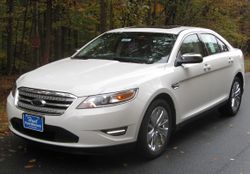 |
|
| Manufacturer | Ford Motor Company |
|---|---|
| Production | 1985–present |
| Model year(s) | 1986–present |
| Predecessor | Ford LTD (1985) Ford Five Hundred (2008) |
| Successor | Ford Fusion (2006 for mid-size) |
| Class | Mid-size (1986–2007) Full-size (2008–present) |
The Ford Taurus is an automobile manufactured by the Ford Motor Company in the United States. Originally introduced in the 1986 model year, it has remained in near-continuous production for more than two decades, making it the fourth oldest nameplate that is currently sold in the North American Ford lineup.[1] It has had a more upscale Mercury branded version entitled the Sable (1986–2005; 2008–2009), as well as a performance variant, the Ford Taurus SHO (1989–1999 and 2010—); in addition, it served as the basis for the first-ever front-wheel drive Lincoln Continental (1988–1994). It was a front-wheel drive mid-size car during its first production run, and it is now a full-size car available in front- or all-wheel drive. It is built on the D3 platform since 2008.
The original Taurus was a milestone design for Ford and the entire American automotive industry, as well as a very influential vehicle that brought many new features and innovations to the marketplace.[2] Since its launch in 1986, Ford has built 7,519,919 Tauruses through the 2007 model year,[3] making it the fifth best selling North American nameplate in Ford's history; only the F-150,[4] Escort,[5] Model T,[6] and Mustang[6] have sold more units. Between 1992 and 1996, the Taurus was the best-selling car in the United States,[7] eventually losing the title to the Toyota Camry in 1997.[8] The 1986-2007 Tauruses were built on the D186 platform.
In the late 1990s and early 2000s, sales of the Taurus declined as it lost market share to Japanese midsize sedans, and as Ford shifted resources towards developing SUVs. It was discontinued in 2006, with production initially ending on October 27, 2006 and 2007 being the last model year.[9] Ford had decided to replace the Taurus with the fullsize Five Hundred and midsize Fusion sedans, as well as replacing the Taurus wagon with the Freestyle crossover SUV. However, Ford revived the Taurus name a few months later during the 2007 Chicago Auto Show by renaming two new models that were intended to be updated versions of the Five Hundred and the Freestyle, the "2008 Taurus" and "2008 Taurus X", respectively.[10][11] A new model of Taurus was then released for the 2010 model year.
Contents |
First generation (1986–1991)
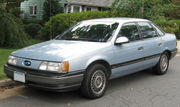
The first-generation Taurus was launched in 1985 as a 1986 model to strong fanfare and sales, replacing the slow-selling mid-size Ford LTD. (The full-size Ford LTD Crown Victoria remained as part of the Ford line up.) Upon the Taurus' debut, Ford was producing a range of rear-wheel drive cars, as Chrysler and General Motors offered more front-wheel drive vehicles. With the introduction of the Escort and Tempo, Ford had started its own transition to front-wheel drive. The Taurus displayed a rounder shape than its contemporaries, often likened to a 'jelly bean' or 'flying potato',[12] inspired by the design of the Audi 5000 and Ford's own Tempo.[2] The aerodynamic design of the Taurus also made the car more fuel efficient, allowing Ford to meet the more stringent corporate average fuel economy (CAFE) standard applied by the United States government.[2] The Taurus' success ultimately led to an American automobile design revolution; Chrysler and General Motors developed aerodynamic cars in order to capitalize on the Taurus' success.[2]
The first generation was available with either a V6 or an inline four-cylinder engine, and came with either a manual or automatic transmission. (The Taurus' twin, the Mercury Sable, has never offered a manual transmission in either of its incarnations.) Along with the exterior of the Taurus, its interior was ahead of its time, and many features originating from it are still used in most cars today.[2] The interior was designed to be extremely user friendly, with all of its controls designed to be recognizable by touch, allowing drivers to operate them without taking their eyes off the road.[2] For example, the switches to the power windows and power locks were designed with one half of the switch raised up, with the other half recessed, in order for its function to be identified by touch.[2] To further enhance this "user friendliness," the dashboard had all of the controls in the central area, within reach of the driver. The left side of the dash also curved slightly around the driver, to make controls easily accessible as well as creating a "cockpit" feel. However, it wasn't curved enough to prevent the passenger from easily identifying and using the vehicle's main controls as well.
The interior of the Taurus was highly customizable to fit buyers' needs, with a large number of options and three different configurations. This meant that the interior of the Taurus could be spartan or luxurious, depending on the buyer's choice of options. On models with an automatic transmission, the Taurus' interior was available in three different seating configurations.[13] The interior equipment depended on model. The most basic model, the L (see below), came standard with just an AM radio and a front cloth bench seat, while the LX, the highest model, came with a high level of standard equipment.
The 1986 Taurus was very well received by both the public and the press. It went on to win many awards, most notably being named Motor Trend's car of the year for 1986,[14] as well as being named on Car and Driver's ten best list for 1986. Over 200,000 Tauruses were sold for the 1986 model year,[2] and in 1989, the millionth Taurus was sold.[2] When production ended in 1991, more than 2,000,000 first generation Tauruses had been sold.[15]
Second generation (1992–1995)

The Taurus received its first cosmetic update in 1992. The second generation dropped the manual transmission and the four-cylinder engine, resulting in all second generation vehicles (with the exception of the Taurus SHO) with automatic transmissions and V6 engines. Length was increased by a few inches, and weight was up a couple of hundred pounds over the previous generation.[16] Every body panel, except for the doors, were redesigned. However, many of the redesigned components closely resembled that of the previous generation, leading many to falsely believe that this generation was just a minor face-lift.[7]
The interior was also completely redesigned for 1992. The Taurus received a new dashboard that, like the previous generation, was designed to be user friendly. All of the vehicle's main controls were located near the left side of the dash, to be within easy reach of the driver. As in the previous generation, all of the controls were designed to be recognizable by touch, and to be operated by drivers without taking their eyes off the road. The new dash also contained three buttons to the right of the gauge cluster that allowed drivers to operate the radio without taking their eyes off the road. The radio was also redesigned, while the rest of the lower dash was carried over from the previous generation, as was the steering wheel.[16] The new dash was also designed to contain a passenger's side airbag, the first time that it was offered in a mainstream sedan.[16] It was optional in 1992, and became standard in 1994, making the Taurus the first car of its kind to have standard dual front airbags.[7]
This generation sold just as well as the first, and became the bestselling car in the United States, a title it would retain for as long as this generation was sold.[7] When production ended in 1995, more than 1,400,000 second generation cars had been sold.[15]
Third generation (1996–1999)


The 1996 model year saw the first complete redesign of the Taurus. It used a controversial new shape that chief designer Jack Telnack claimed was penned to make the Taurus stand out to sedan buyers, and compared the current Taurus to the likeness of a pair of slippers.[17] This shape was based upon an oval, which was perhaps inspired by Ford's own logo,[7][18] and while the previous Taurus used a flat, streamlined shape, this Taurus used a rounded shape similar to that of the Chrysler Concorde. Station wagons also got new sheet metal, although from the firewall back, the Taurus and Mercury Sable wagons again shared the same panels, with all station wagon doors being the same as those used on the Sable sedans. As the new-generation Taurus was aimed at a more mature, affluent customer base,[17] its exterior contained many upscale styling touches. For example, the LX offered optional chrome alloy wheels and optional chrome dual exhaust tips. This newer model also displayed a "Taurus" badge on the back written in script, as opposed to the block letters used in previous generations.[19]
The interior was also completely redesigned for the 1996 model year. Like that of the previous two generations, the interior was designed to be user friendly.[18] The dashboard wrapped slightly around the driver; all of the main controls were placed within easy reach, and were designed to be recognizable by touch and to be operated by drivers without taking their eyes off the road. The controls for the radio and climate control were combined into an oval shaped "Integrated Control Panel" mounted in the center of the dash, which was created in response to many complaints from Taurus owners that they couldn't easily operate the main controls of the radios and climate control systems without taking their eyes off the road.[20] Another new innovation was the "Flip-Fold" center console, in which on bench seat equipped cars, the middle section could be transformed into a console; the seat cushion folded out into a console with a lockable storage bin and cupholders, while the seatback folded down to become an armrest.[19] A traditional center console with a floor mounted shifter was installed on cars equipped with bucket seats.[19]
Reaction to this new generation of Taurus was mixed. Ford found that customers were turned off by the car's oval shape, and although it managed to retain its title as the bestselling car in the United States, this was only because of heavy sales to rental fleets; 51% of all Taurus sales for 1996 went to rental fleets, in contrast to the Honda Accord and Toyota Camry, of which most sales were to private customers through retail outlets.[21] The Taurus would go on to lose its bestselling title in 1997 to the Camry.[7] This Taurus was sold in Australia alongside the locally produced Ford Falcon, but imports ceased in 1999 due to poor sales.[22]
Fourth generation (2000–2007)

The Taurus received another redesign for 2000, which replaced many of the oval derived design elements of the previous model. To reduce the price and keep it competitive, Ford did cost cutting on the car in 1999, such as giving the Taurus sedan rear drum brakes on ABS equipped vehicles (previously, upgrading to ABS included the addition of rear disc brakes), eliminating the dual exhaust on the higher end models, and trimming many other small features.
Ford designed the fourth generation with much more conservative styling in hopes of increasing the car's appeal. Instead of sloping back, this car's trunk stood upright in a more traditional shape, which increased trunk space by another two cubic feet.[23][24] The roof was also raised into a more upright stance to increase headroom, which can be evidenced by the thicker C-pillar and larger area between the tops of the doors and the top of the roof.
The interior was also completely redesigned with a more conservative shape, although some features from the previous Taurus generations were carried over. The dashboard was redesigned with a more conservative design that went straight across the front, instead of curving around the driver as in the previous generation. The "integrated control panel" concept was carried over but redesigned, with a bigger, square shape, and placed in the center of the dash instead of being angled toward the driver. The flip-fold center console was also carried over from the previous generation, although it was revamped as well. When folded out, it now rested against the floor instead of the dashboard, and had revamped cup holders and storage areas.[24] Unlike the previous three Taurus's, the fourth generation offered rear cup holders that either slid or folded out of the front console, depending on which console the car was equipped with.[24]
Initial discontinuation and revival
Taurus sales had slumped significantly in the years prior to its demise, losing significant market share to Japanese sedans.[8] Due to waning popularity and customer demand, Ford decided to slowly discontinue the Taurus. Production of the Taurus wagon was discontinued on December 8, 2004;[24] sedan retail sales halted after a short 2006 model year, and the Taurus became sold exclusively to fleets in the United States, while still being sold to retail customers in Canada. Production ended on October 27, 2006, as Ford idled the Atlanta plant, as part of its The Way Forward restructuring plan.
How can it go away? It's the best selling car in America.
The last mid-size Ford Taurus rolled off the assembly line around 7:00am,[26] destined for delivery to S. Truett Cathy, owner of Chick-fil-A.[27] Mr. Cathy's original restaurant was located across from the Ford Atlanta plant. There was no official event or function of any kind to mark the end of production.[28] Ford had decided to replace the Taurus with the fullsize Five Hundred and midsize Fusion sedans, as well as replacing the Taurus wagon with the Freestyle crossover SUV.
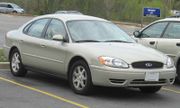
The discontinuation of the Taurus was controversial. While many believed that the Taurus was discontinued because it could no longer compete in the growing sedan market,[29] others believed that if Ford wanted to save the car, they could have easily done so.[30] Autoblog went as far as calling the Taurus the biggest fall from grace in history, and even blamed Ford's current financial problems on their failure to keep the Taurus competitive, as well as how they focused nearly all of their development resources and marketing on trucks and SUVs.[31] The Truth About Cars published a review/editorial also showing their disappointment at how Ford neglected the Taurus to the point where it became a "rental car".[32]
MSNBC interviewed many Ford workers who felt that Ford unjustly abandoned the car that had done so much to revitalize Ford and the US industry. In an October 25, 2006 USA Today editorial, "How Ford starved its Taurus" it was noted that the Japanese stick with their winners and make them better (such as the Toyota Corolla, which has been in continuous production since the 1960s),[33] while Detroit automakers retire cars and even entire division nameplates in search of "the next big thing".[34]
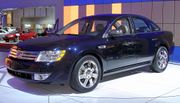
However, after Alan Mulally took position as Ford's CEO, rumors were rampant that he was interested in reviving the Taurus. These were fueled by the fact that he said in an interview with the Associated Press that he was baffled to find out that the Taurus had been discontinued when taking position as CEO at Ford, as well as stating that he believed that discontinuing the Taurus was a mistake, and that the Five Hundred should have been named "Taurus" from the beginning.[25] The rumors of a possible Taurus revival were confirmed in early 2007, when the revamped versions of the Five Hundred and Freestyle were unveiled as "Taurus" and "Taurus X" at the 2007 Chicago Auto Show, a decision that was influenced strongly by Mulally.[25] In a later interview, Mulally explained that the fact that the Taurus was well known and had a positive brand equity associated with it strongly influenced his decision to revive the name.[35]
Fifth generation (2008–2009)
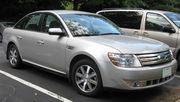
The fifth generation was developed from the Ford Five Hundred, which was scheduled for a significant styling facelift and power upgrade for the 2008 model year. Ford decided to designate that model as the Taurus to take advantage of its customer recognition and dealer demand.[36] The 2008 Ford Taurus went into production in 2007 as a 2008 model. It was determined that Ford's strategy to redesignate new cars in the lineup with new names beginning with the letter F, as in Ford Focus, Ford Fusion, and Ford Freestyle, was not a good marketing move, as some of the renamed cars had highly recognizable iconic names. Car buyers in the U.S. did not associate the new F names with Ford, and were confused by the name changes.[10][37] Mulally believed that the Taurus had an immediately strong brand equity, and that it would take years for consumers to have a similar recognition of the Five Hundred.[38]
There were more than 500 changes to the new Taurus from the existing Five Hundred, including a new front end and the 263 hp 3.5 L Duratec 35 V6, which replaces the 203 hp (151 kW) Duratec 30 3.0 L V6. The Five Hundred/Freestyle's ZF-Batavia CVT, which had maximum torque of 221 lb·ft (300 N·m), was also replaced with a Ford-GM joint venture six-speed automatic with additional torque of the Duratec 35. The Aisin AW six-speed automatic which was used on FWD Five Hundred and Montegos was also replaced by the new six-speed.[39] The Taurus sedan twin, the Mercury Sable nameplate, was revived from the Mercury Montego.[10][40][41] For the 2009 model year, Ford revived the "SE" trimline for the Taurus. The SE sells for $24,125 according to Ford's website and now serves as the base model for the vehicle.
This generation of the Taurus is sold in the Middle East as the Ford Five Hundred from 2008.[42]
Sixth generation (2010–)
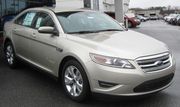
The 2010 Ford Taurus was revealed at the Detroit International Auto Show in 2009 at Cobo Hall.[43] The press preview of the Taurus and Taurus SHO was held in Asheville, North Carolina from June 15 to June 19, 2009.
The Ford scored well in test drives, and the media was pleased with some of the new features available in the 2010 Ford Taurus.[44] Some of these features include all wheel drive, cross traffic alert, collision warning, blind spot monitoring and adaptive cruise control. However, others criticized the lack of interior room and reduced sight lines, despite its full-sized exterior,[45] and Edmunds noted that the eighth-generation Honda Accord (which competes in the midsize category) had superior driving dynamics and a more efficient design, and offered almost as much interior space as the Taurus despite considerably smaller external dimensions.[46]
The base price of the base SE model is $25,995. The mid grade SEL is priced at $27,995, and the top level Limited, at $31,995. Ford hopes to achieve a mix of 10% to 15% with its high-performance SHO model.
The Ford Taurus SHO, released in August 2009, is the high-performance version of the Ford Taurus.[47] The SHO is powered by Ford's new EcoBoost 3.5L V6 engine. The twin-turbocharged, gasoline direct injection power plant has 365 horsepower (272 kW) and 350 lb·ft (470 N·m) of torque. The EcoBoost V6 achieves the same fuel economy as the base 3.5L V6. The Taurus SHO base price is $37,995 which includes the EcoBoost V6, all wheel drive, upgraded 6-speed automatic transmission and numerous exterior and interior trim upgrades. A fully loaded SHO will be $45,000. There is also an optional performance package on the new SHO, which includes upgraded brake pads, a 3.16:1 final drive ratio (compared to the standard 2.77:1), recalibrated electronic power steering, further suspension tuning, a recalibrated ESC (Electronic Stability Control) with sport mode and summer compound Goodyear Eagle F1 245/45ZR20 tires, albeit to the exclusion of many feature options like Power Sunroof, Heated/Cooled Seats, Multi-Contour Seats, Auto-Sensing Lights and Wipers, Adaptive Cruise Control, Adjustable Pedals, Blind Spot Information System (BLIS), and Satellite Navigation.[48]
See also
- List of Ford Taurus models
- Ford Taurus SHO
- Ford Taurus X
- Mercury Sable
References and footnotes
- ↑ The only vehicles in Ford's current North American product line that have been in production longer than the Taurus are the Ford Ranger, Ford Mustang, and Ford F-150.
- ↑ 2.0 2.1 2.2 2.3 2.4 2.5 2.6 2.7 2.8 Taub, Eric (November 1991). Taurus: The Making of the Car That Saved Ford. E. P. Dutton. ISBN 0525933727.
- ↑ "Production Figures". Taurus/Sable Encyclopedia. Taurus Car Club of America. http://www.ford-taurus.org/taurusinfo/Specs/Production.php. Retrieved 2009-09-25.
- ↑ O'Neil, Mike. "Ford's F-Series sets industry truck sales records "Ford's F-series sets industry sales truck records". Ford Trucks.com. http://www.ford-trucks.com/news/idx/12/247/2005/article/01122005 "Ford's F-Series sets industry truck sales records. Retrieved 2008-04-04.
- ↑ "Farewell, Ford Escort". Media.Ford.com. 2000-07-21. http://media.ford.com/article_display.cfm?article_id=5429. Retrieved 2008-04-04.
- ↑ 6.0 6.1 O'Neill, Mike (2004-05-05). "Ford Nameplates join Five Million Club". Media.Ford.com. Archived from the original on 2007-10-15. http://web.archive.org/web/20071015154444/http://media.ford.com/newsroom/feature_display.cfm?release=17697. Retrieved 2008-04-04.
- ↑ 7.0 7.1 7.2 7.3 7.4 7.5 DiPetro, John (2003-04-18). "Inside Line: Ford Taurus/Mercury Sable". Edmunds. Archived from the original on 2006-06-15. http://web.archive.org/web/20060615011127/http://www.edmunds.com/insideline/do/Features/articleId=46007. Retrieved 2006-05-29.
- ↑ 8.0 8.1 Mayne, Eric (2005-04-19). "End of Ford Taurus closes era". Detroit News. http://www.detnews.com/2005/autosinsider/0504/19/C01-154989.htm. Retrieved 2006-05-16.
- ↑ "Last Taurus Rolls Off Ford Assembly Line". Fox News. 2006-10-27. http://www.foxnews.com/story/0,2933,225932,00.html. Retrieved 2006-10-27.
- ↑ 10.0 10.1 10.2 "2008 Ford Taurus features more power, style, and more standard safety features". Media. Ford.com. 2007-02-07. http://media.ford.com/article_display.cfm?article_id=25372. Retrieved 2007-02-07.
- ↑ "Ford strengthens crossover leadership with introduction of new 2008 Taurus X". Media. Ford.com. 2007-02-07. http://media.ford.com/article_display.cfm?article_id=25373. Retrieved 2007-02-07.
- ↑ Schneiderman, R.M. (2006-10-27). "Ford Taurus, R.I.P.". Forbes. http://www.forbes.com/2006/10/27/ford-taurus-demise-cx_rs_1027autofacescan01.html. Retrieved 2007-06-29.
- ↑ The interior could be ordered with a traditional column-mounted shifter and front bench seat, with bucket seats and a center console with a floor mounted shifter, or with buckets seats and a console with a column mounted shifter. (These options were also extended to the Sable and, beginning in 1988, the Lincoln Continental.) However, models available with a manual transmission were only available in one configuration: bucket seats with a center console and floor mounted shifter.
- ↑ Hanson, John. "Car of the Year 1986: It is Going To Be a Bull Market For The Ford Taurus". Motor Trend (February 1986): 23–36.
- ↑ 15.0 15.1 "1986-1997 Ford Taurus production numbers". Taurus Car Club of America. http://www.ford-taurus.org/taurusinfo/Specs/Production.php. Retrieved 2008-09-12.
- ↑ 16.0 16.1 16.2 "Taurus/Sable Spotter's Guide: Second Generation (1992-1995)". Taurus Car Club of America. http://www.ford-taurus.org/taurusinfo/G2/index.php. Retrieved 2008-04-05.
- ↑ 17.0 17.1 Sedgwick, David. "Taurus for '96 will dare to stand out in competitive sedan market". The Detroit News: 1C–2C.
- ↑ 18.0 18.1 Walton, Mary (May 1997). Car: A Drama of The American Workplace. W. W. Norton. ISBN 0393040801.
- ↑ 19.0 19.1 19.2 "Taurus/Sable Spotter's Guide Generation 3". Taurus/Sable Encyclopedia. Taurus Car Club of America. 2006-10-30. http://www.ford-taurus.org/taurusinfo/G3/index.php. Retrieved 2007-02-25.
- ↑ Pierson, John. "How Ford Added a Dash of Design To Its New Taurus". Chicago Sun-Times.
- ↑ Encyclopedia of American Cars. Publications International. 2006. ISBN 1412713544.
- ↑ "Ford Taurus 1996-1998 - www.drive.com.au". http://www.drive.com.au/Editorial/ArticleDetail.aspx?ArticleID=9501&IsPgd=0. Retrieved 2009-10-07.
- ↑ "2000-2006 Ford Taurus overview". Consumer Guide. http://consumerguideauto.howstuffworks.com/2000-to-2006-ford-taurus.htm. Retrieved 2007-02-13.
- ↑ 24.0 24.1 24.2 24.3 "Taurus/Sable spotter's guide (Generation 4 2000-2007)". Taurus Car Club of America. http://www.ford-taurus.org/taurusinfo/G4/index.php. Retrieved 2008-04-06.
- ↑ 25.0 25.1 25.2 "CEO insisted in bringing "Taurus" back". MSNBC. 2007-02-07. http://www.msnbc.msn.com/id/17033668/. Retrieved 2007-07-26.
- ↑ "Last Ford Taurus built today". Left Lane News. 2006-10-27. http://www.leftlanenews.com/last-ford-taurus-built-today.html.
- ↑ "Last Ford Taurus rolls off Atlanta Assembly line". USA Today. 2006-10-27. http://www.usatoday.com/money/autos/2006-10-27-taurus-farewell_x.htm. Retrieved 2007-08-14.
- ↑ "Ford Taurus out of gas". seattlepi.com. 2006-10-20. http://www.seattlepi.com/business/289400_lasttaurus20.html. Retrieved 2007-08-14.
- ↑ "Storied Ford Taurus reaches end of line". Detroit News. 2006-10-23. http://detnews.com/apps/pbcs.dll/article?AID=/20061023/AUTO01/610230304/1148. Retrieved 2007-08-14.
- ↑ Final Ford Taurus interview. ABC News. 2007-07-26. http://www.youtube.com/watch?v=CwuCm8hNXgI.
- ↑ "So long, friend. Ford producing last Taurus next week". Autoblog. http://www.autoblog.com/2006/10/19/so-long-friend-ford-producing-the-last-taurus-next-week/. Retrieved 2007-07-26.
- ↑ "Ford Taurus: Oedipus Wrecks". The Truth About Cars. http://www.thetruthaboutcars.com/ford-taurus-oedipus-wrecks/. Retrieved 2008-04-05.
- ↑ "Toyota Corolla history". Edmunds.com. http://www.edmunds.com/toyota/corolla/history.html. Retrieved 2008-04-04.
- ↑ "How Ford starved its Taurus". USA Today. 2006-10-25. http://www.usatoday.com/news/opinion/editorials/2006-10-24-ford-taurus_x.htm. Retrieved 2006-10-25.
- ↑ Ford CEO Alan Mulally on the new Ford Taurus. Autoinsider news. 2007-07-26. http://www.youtube.com/watch?v=uYlNOtqI8tc.
- ↑ "Five Hundred To Be Renamed Taurus". stangbangers.com. http://www.stangbangers.com/News_FordFiveHundred.htm. Retrieved 2007-07-26.
- ↑ "Five Hundred to be renamed "Taurus"". MSNBC.com. 2007-02-06. http://www.leftlanenews.com/ford-five-hundred-to-be-renamed-taurus.html. Retrieved 2007-02-07.
- ↑ Krisher, Tom (2007-02-06). "Officials say Ford to revive Taurus name". BusinessWeek.com. http://www.businessweek.com/ap/financialnews/D8N48NI80.htm. Retrieved 2007-02-07.
- ↑ Siler, Steve, and Mike Dushane (February 2007). "Ford slaps a once-successful nameplate on its refreshed and reinvigorated Five Hundred". Car and Driver. http://www.caranddriver.com/news/car/07q1/2008_ford_taurus-auto_shows. Retrieved 2007-02-25.
- ↑ "Like Taurus, Mercury Sable nameplate to return". Leftlanenews.com. http://www.leftlanenews.com/like-taurus-mercury-sable-nameplate-to-return.html. Retrieved 2007-02-07.
- ↑ "Mercury Sable Returns to Showrooms With More Power, Style and Sophistication". Media. Ford.com. http://media.ford.com/article_display.cfm?article_id=25374. Retrieved 2007-02-07.
- ↑ "So we got a Ford Five Hundred". DriveArabia.com. http://www.drivearabia.com/news/2008/02/10/so-we-got-a-ford-five-hundred/. Retrieved 2008-02-11.
- ↑ "2010 Ford Taurus: A Flagship Returns - 2010 ford taurus". Jalopnik. 2009-01-11. http://jalopnik.com/5128405/2010-ford-taurus-a-flagship-returns. Retrieved 2009-12-12.
- ↑ 2010 Ford Taurus First Drive
- ↑ Ulrich, Lawrence (2009-12-27). "A Holiday From Wishful Thinking". The New York Times. http://www.nytimes.com/2009/12/27/automobiles/27ulrich-best.html?pagewanted=2&_r=1&sq=Ford%20Taurus%20disappointing&st=cse&scp=1. Retrieved 2010-05-02.
- ↑ 2010 Ford Taurus vs. 2009 Honda Accord Comparison Test on Inside Line
- ↑ First Drive Ford Taurus Sho
- ↑ "2010 Ford Taurus SHO - First Look - Latest News, Features, and Reviews - Automobile Magazine". Automobilemag.com. 2009-02-11. http://www.automobilemag.com/new_and_future_cars/2010/0902_2010_ford_taurus_sho/index.html. Retrieved 2009-12-12.
External links
- Official Ford website
- Taurus & Sable Owners' Club TSOC -- A Community for Ford Taurus and Mercury Sable Owners and Enthusiasts.
- Taurus Car Club of America
- Ford Taurus Specifications and Photos
- Archived NHTSA crash test results
|
||||||||||||||
|
|||||||||||||||||
| Type | 1980s | 1990s | 2000s | 2010s | ||||||||||||||||||||||||||||
| 0 | 1 | 2 | 3 | 4 | 5 | 6 | 7 | 8 | 9 | 0 | 1 | 2 | 3 | 4 | 5 | 6 | 7 | 8 | 9 | 0 | 1 | 2 | 3 | 4 | 5 | 6 | 7 | 8 | 9 | 0 | 1 | |
| Subcompact | Fiesta | Festiva | Aspire | Fiesta | ||||||||||||||||||||||||||||
| Compact | Fairmont | Tempo | Tempo | Contour | ||||||||||||||||||||||||||||
| Pinto | Escort | Escort | Escort | |||||||||||||||||||||||||||||
| Focus | Focus | |||||||||||||||||||||||||||||||
| Mid-size | Granada | LTD | Fusion | |||||||||||||||||||||||||||||
| Taurus | Taurus | Taurus | Taurus | |||||||||||||||||||||||||||||
| Full-size | LTD | LTD Crown Victoria | Crown Victoria | Crown Victoria | ||||||||||||||||||||||||||||
| Country Squire | Five Hundred | Taurus | Taurus | |||||||||||||||||||||||||||||
| Personal luxury | Thunderbird | Thunderbird | Thunderbird | Thunderbird | ||||||||||||||||||||||||||||
| Sport compact | EXP | EXP | Probe | Probe | Escort ZX2 | ZX2 | ||||||||||||||||||||||||||
| Sports | Mustang | Mustang | Mustang | |||||||||||||||||||||||||||||
| GT | ||||||||||||||||||||||||||||||||